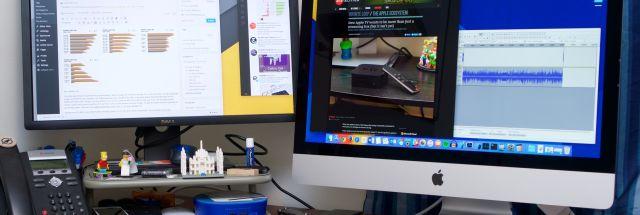reader comments
201
with 94 posters participating, including story author
Share this story
Share on Facebook
Share on Twitter
Share on Reddit
The 5K iMac on a desk.
The 27-inch iMac retains the RAM hatch for easy upgrades. Apple sells them with up to 32GB of RAM, but Skylake can support up to 64GB.
This is the 2012 model, but the mechanism is unchanged in the 5K iMac.
Lifting the hatch to take the RAM out.
A couple of weeks back, we took a look at
the new 21.5-inch 4K iMac
. It’s a solid desktop with a great screen, though its default configuration leaves something to be desired (particularly its slow 5400RPM hard drive).
If you really ask a lot of your computing equipment, though, there’s still no substitute for the 27-inch 5K version. More divides the small and large iMacs than ever before: the 27-inch versions include new Skylake processors from Intel, while the 21-inch versions use the older Broadwell architecture. You can only get dedicated GPUs in the 5K iMacs. The Mac Pro is still Apple’s fastest Mac if your workloads routinely max out multiple CPU cores and GPUs, but for other power users and pros the 27-inch iMac is the one to get.
The outside
We’re going to keep this really, really short, because very little has changed about the exterior of the 5K iMac. Even some of the internal upgrades that were new to the 21.5-inch models—Thunderbolt 2, for one—were already included in the 27-inch model last year.
Specs at a glance: 27-inch 2015 5K iMac
Screen
5120×2880 27" IPS display (217 ppi)
OS
Mac OS X 10.11.1
CPU
4.0GHz Intel Core i7-6700K (Turbo Boost 4.2GHz)
RAM
32GB 1867MHz DDR3
GPU
AMD Radeon R9 M395X with 4GB GDDR4 RAM
Storage
1TB NVMe SSD, four PCIe 2.0 lanes
Networking
1.3Gbps 802.11ac, Bluetooth 4.0, gigabit Ethernet
Ports
4x USB 3.0, 2x Thunderbolt 2, headphone jack, SD card slot
Size
20.3 x 25.6 x 8 inches (51.6 x 65.0 x 20.3 cm)

Weight
21 lbs (9.54 kg)
Starting price
$1,799
As reviewed
$4,099
Other perks
FaceTime HD camera, dual noise-canceling mics, ambient light sensor, Kensington lock slot
One improvement is a wider color gamut, the same one we saw in the 4K iMac. Previous iMacs used the sRGB color space, but the new Retina models support "over 99 percent" of the
DCI-P3
color space
common in digital movie theaters
. DCI-P3 encompasses the entire sRGB color space but is capable of displaying more shades of red and green (which also affects secondary and tertiary colors like yellow, orange, magenta, and cyan, though blues in DCI-P3 are roughly the same as in sRGB).
To support this wider color gamut, Apple has switched away from using standard white LEDs for backlighting, whi
ch typically combine a blue LED with a yellow phosphor to create white. Apple is now using red-green phosphor LEDs to expand the color gamut, a strategypreviously demonstrated by LCD makers like Sharp
.
Also new are the
input devices
, the Magic Keyboard, Magic Mouse 2, and Magic Trackpad 2. All three replace AA batteries with rechargeable li-ion versions. The mouse looks pretty much the same, but the keyboard and trackpad are both slimmed down and streamlined.
Advertisement
Lightning cables are used to recharge the accessories, but they'll also carry data when connected to your Mac. This obviates the need for separate wired and wireless versions, since any wireless accessory effectively becomes a wired accessory when you plug it in (that said, the placement of the Lightning port on the bottom of the Magic Mouse 2 makes this impractical). When you plug in the accessories to a Mac running El Capitan, they’ll also automatically pair with it.
The keyboard and mouse are included with all iMacs for no additional charge, but the trackpad will cost $50 extra.
The inside
Further Reading
Intel’s Skylake Core i7-6700K reviewed: Modest gains from a full Tick-Tock cycle
Here’s where we get to the fun stuff. The new iMacs jump two CPU generations, one GPU generation, and double the amount of storage bandwidth that the old ones had.
Apple sent us the fastest version of the 27-inch iMac that it makes, complete with 32GB of RAM and a 1TB SSD—this computer retails for an eye-popping $4,099, though a full $1,300 of that is wrapped up in storage and memory upgrades. It’s pricey, but boy is it fast.
The CPU is a Core i7-6700K, a 4.0GHz (4.2GHz Turbo) high-end, quad-core Skylake CPU that
we’ve actually already reviewed
. Intel’s year-over-year CPU performance gains have slowed in recent years, so if you’ve already got a similarly clocked Haswell chip the gains are relatively small. If you’re replacing a quad-core iMac from 2010 or 2011, you can expect to see some more significant boosts. We pulled results for half a decade of high-end iMacs (plus the fastest 4K iMac with Broadwell) from the
Geekbench results database
to illustrate.
This iMac also widens the performance gap between it and the quad-core version of the Mac Pro—with the 6700K, it’s the undisputed single-core performance champion, the fastest processor you can get in any Mac in the entire lineup. Multithreaded tasks still do better with more cores, though, so if you want 6, 8, or 12 CPU cores, the Mac Pro is still the only way to go. The 5K iMac actually stands up fairly well to the 6-core Mac Pro, but the 8- and 12-core versions still blow it away. If Apple ever gets around to updating its pro desktop again, Intel even has
single-socket Xeon CPUs with 14, 16, and 18 cores
now.




